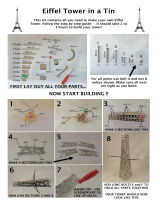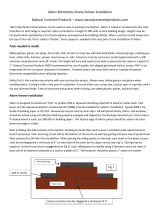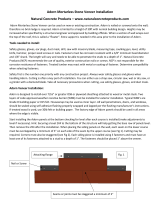Lego 21036 Architecture Building Instructions
- Type
- Building Instructions
This manual is also suitable for
Lego 21036 Architecture
The Lego 21036 Architecture is a Lego set that allows you to build a detailed model of the Arc de Triomphe. The set includes 386 pieces and is recommended for ages 12 and up.
Once built, the model is 49.5 cm (19.5 in) high, 45 cm (17.7 in) wide, and 22 cm (8.7 in) deep. It features intricate details, such as the sculpted reliefs on the pillars and the eternal flame beneath the arch.
The set also includes a booklet with information about the history and architecture of the Arc de Triomphe.
Lego 21036 Architecture
The Lego 21036 Architecture is a Lego set that allows you to build a detailed model of the Arc de Triomphe. The set includes 386 pieces and is recommended for ages 12 and up.
Once built, the model is 49.5 cm (19.5 in) high, 45 cm (17.7 in) wide, and 22 cm (8.7 in) deep. It features intricate details, such as the sculpted reliefs on the pillars and the eternal flame beneath the arch.
The set also includes a booklet with information about the history and architecture of the Arc de Triomphe.




















-
 1
1
-
 2
2
-
 3
3
-
 4
4
-
 5
5
-
 6
6
-
 7
7
-
 8
8
-
 9
9
-
 10
10
-
 11
11
-
 12
12
-
 13
13
-
 14
14
-
 15
15
-
 16
16
-
 17
17
-
 18
18
-
 19
19
-
 20
20
-
 21
21
-
 22
22
-
 23
23
-
 24
24
-
 25
25
-
 26
26
-
 27
27
-
 28
28
-
 29
29
-
 30
30
-
 31
31
-
 32
32
-
 33
33
-
 34
34
-
 35
35
-
 36
36
-
 37
37
-
 38
38
-
 39
39
-
 40
40
-
 41
41
-
 42
42
-
 43
43
-
 44
44
-
 45
45
-
 46
46
-
 47
47
-
 48
48
-
 49
49
-
 50
50
-
 51
51
-
 52
52
-
 53
53
-
 54
54
-
 55
55
-
 56
56
-
 57
57
-
 58
58
-
 59
59
-
 60
60
-
 61
61
-
 62
62
-
 63
63
-
 64
64
-
 65
65
-
 66
66
-
 67
67
-
 68
68
-
 69
69
-
 70
70
-
 71
71
-
 72
72
-
 73
73
-
 74
74
-
 75
75
-
 76
76
-
 77
77
-
 78
78
-
 79
79
-
 80
80
-
 81
81
-
 82
82
-
 83
83
-
 84
84
-
 85
85
-
 86
86
-
 87
87
-
 88
88
Lego 21036 Architecture Building Instructions
- Type
- Building Instructions
- This manual is also suitable for
Lego 21036 Architecture
The Lego 21036 Architecture is a Lego set that allows you to build a detailed model of the Arc de Triomphe. The set includes 386 pieces and is recommended for ages 12 and up.
Once built, the model is 49.5 cm (19.5 in) high, 45 cm (17.7 in) wide, and 22 cm (8.7 in) deep. It features intricate details, such as the sculpted reliefs on the pillars and the eternal flame beneath the arch.
The set also includes a booklet with information about the history and architecture of the Arc de Triomphe.
Ask a question and I''ll find the answer in the document
Finding information in a document is now easier with AI
Related papers
-
Lego 10219 Building Instruction
-
Lego 40416 Building Instructions
-
Lego 31313 Mindstorms Building Instruction
-
Lego 30628 Harry Potter Building Instructions
-
Lego 2000456 Building Instructions
-
Lego 71380 Super Mario Building Instructions
-
Lego 30051 Building Instruction
-
Lego 71383 Super Mario Building Instructions
-
Lego 30050 Building Instruction
-
Lego 10134 Star Wars Owner's manual
Other documents
-
Global Direct 21050 Installation guide
-
 Adorn BPILL Installation guide
Adorn BPILL Installation guide
-
LIGHT MY BRICKS 21030 Operating instructions
-
Solstice Sculptures XST/441 User manual
-
 Apples to Pears Eiffel Tower in a Tin Quick start guide
Apples to Pears Eiffel Tower in a Tin Quick start guide
-
 Adorn SFLAT Installation guide
Adorn SFLAT Installation guide
-
 Adorn SFLAT User manual
Adorn SFLAT User manual
-
John Lewis COLOSSEUM Assembly
-
LEXON LL128 Nomaday Lock User manual
-
LEXON LL129 Fine Bag Light 2 Operating instructions



























































































